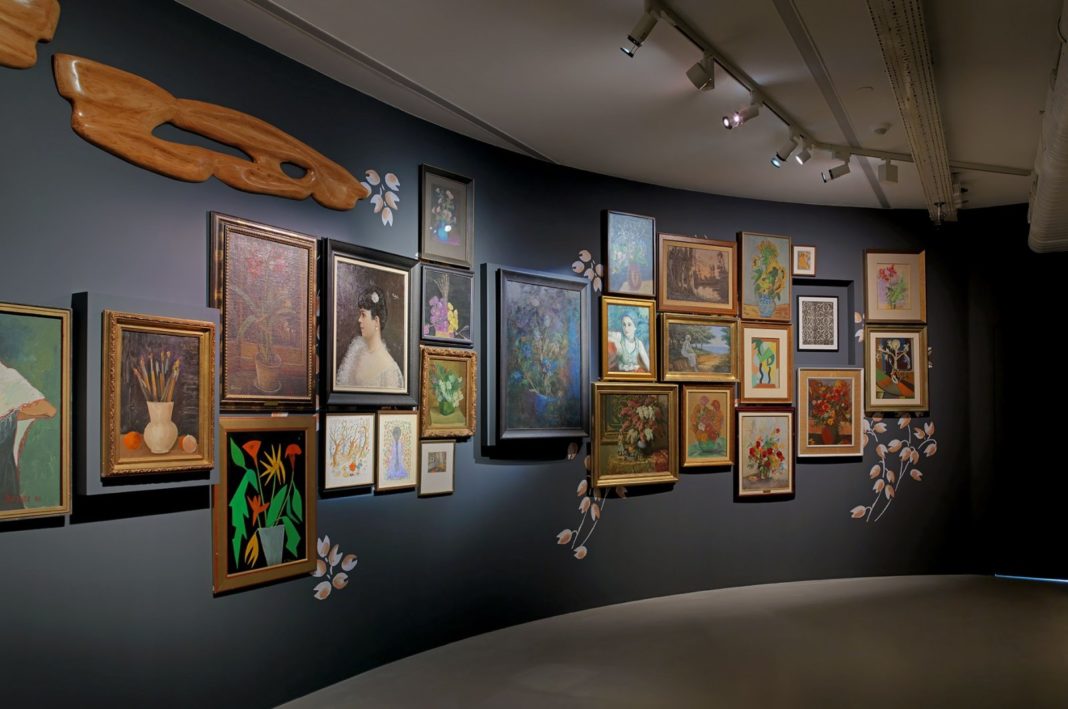« “I-You-They: A Century of Artist Women,” at Istanbul’s Mesher gallery, explores early artists who have largely been neglected in the canon, inviting today’s artists to re-examine their roots » says Ayla Jean Yackley in Al-Monitor.
While visiting the home of the late textile artist Nasra Simmeshindi, acclaimed Turkish artist Kutlug Ataman noticed a strip of her ceiling painted azure blue. Simmeshindi told Ataman that the silsel, or “fluttering of wings” in the Aramaic dialect of southeast Turkey, served as a substitute sky when she could not wander outside. The motif became the basis for Ataman’s 2012 tapestry “Silsel.”
Now Simmeshindi’s own work is on display in “I-You-They: A Century of Artist Women” at Istanbul’s Mesher gallery through May 29, an expansive exhibition that seeks to amend the record on who paved the way for Turkish contemporary artists. Curated by Deniz Artun, the show features 117 artists who lived and worked in Turkey between 1850 and 1950, many of them ignored by art historians until now.
“Art history in Turkey has largely skipped past and failed to record many women … leaving them in the shadows,” said Artun. “We cannot correct art history with one exhibition. Our objective instead is to open the door slightly, to leave it ajar so that others can push through.”
Underrepresentation of female artists in museums, galleries and textbooks is hardly Turkey’s problem alone. The nub of “I-You-They” is the seminal essay “Why Have There Been No Great Women Artists?” from 1971, in which the art historian Linda Nochlin skewered the very notion of “Great Art” in a world that long barred half of the population from art schools, salons and apprenticeships.
Researchers at Mesher spent more than two years combing private collections, foreign museums and family attics to select the 232 paintings, sculptures, engravings and photographs. They relied on word of mouth, asking known artists for more connections to discover generations of lost artists.
What emerges is a decidedly egalitarian show, with work by celebrated artists — like the modernist painter Fahrelnissa Zeid, her sister Aliye Berger, an engraver, and their ceramicist niece Fureya Koral — exhibited next to undated, unsigned oil paintings or charcoal sketches. Non-Muslim artists also occupy a prominent place.
The eponymous work is from the early 1990s by Sukran Aziz, in which the words “I,” “you” and “they” are written in foil-cut letters on a wooden grid in 13 different languages. Implicit is “we,” as the networks that helped Artun and her team build the show run like a thread throughout.
The pronouns serve as signposts for each floor, with portraiture on the “I” level; depictions of family, motherhood and other conventional roles in “You;” and more than 100 works, mostly still-life paintings, hung salon-style in “They,” signifying the decorative pastime to which women were largely confined.
Among the portraits is a pencil-on-paper drawing by Belkis Mustafa, the first alumna of the Ottoman fine arts academy after coeducation was introduced. The untitled sketch is of a woman’s torso, neck and head, while her face is incomplete beyond the jawline, evoking the invisibility of early Turkish women artists.
Belkis also painted nudes, a rarity in a conservative society, which handicapped early female painters. Yet “I-You-They” includes several examples, such as the hulking female figure in Celile Uguraldim’s 1949 “Nude,” likely painted from a male model. Uguraldim, who studied under the Italian Realist Fausto Zonaro, spent the last years of her life blind and fighting for the release of her son, the poet Nazim Hikmet. He died in exile in 1963, eight years after his mother’s death.
The century covered by the exhibit coincides with Turkey’s adoption of Western-style figurative art, the collapse of the Ottoman Empire and the birth of the secular republic. The tumult of the art and political worlds ripples throughout.
Sculptor Iraida Barry was another early student at the Istanbul art academy after her plans to study in St. Petersburg were upended by the 1917 Russian Revolution and she, along with 200,000 other White Russians, fled to Istanbul. Barry’s work appeared at the 1937 opening of the Museum of Painting and Sculpture, which houses Turkey’s national modern art collection. At Mesher, her confident, organic sculpture includes the plaster bust “A Child’s Head,” slightly battered by decades of neglect as the artist slipped into obscurity.
Among the groundbreaking photographers is Hatice Sahiye Barlas, who dons a fez and man’s suit to stare assuredly into the camera lens and invert the male gaze in her self-portrait from the 1890s. Elisa Pante Zonaro, who was married to the painter, crosses the threshold between the public and private spheres with shots of family life and a sultan’s procession.
A child in striped pajamas sits jauntily next to an enormous doll in a portrait by Turkey’s first female studio photographer, Maryam Sahinyan, whose “methodological use of props and sets, poses and gestures [were] employed with the rigor and precision of a conceptual artist,” according to an earlier essay by Turkish curator Vasif Kortun.
Three of Simmeshindi’s textiles, called hetmo by Syriac Christians, are part of the exhibition, including an untitled devotional depiction of St. George from 1995, reminiscent of the curtains she produced for churches. A third-generation block printer, Simmeshindi painted thousands of textiles before her death in 2016 at the age of 92, receiving some recognition in the last years of her life for keeping the centuries-old art form alive.
The “vicious cycle” that kept Turkish women out of galleries and, in turn, out of the studio making art has been largely broken in this century, Artun said. “Now women are visible, and are more making the most exciting work in Turkey. But there remains a great misfortune, that they remain cut off from their roots. To be truly powerful artists, they first need to know where they came from. »
Al-Monitor, May 27, 2022, Ayla Jean Yackley

